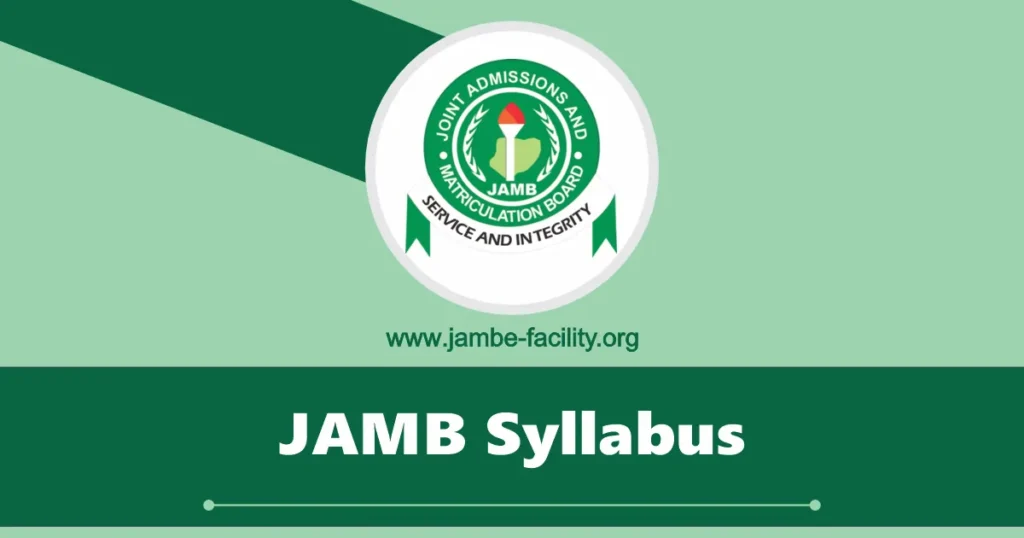Download the complete JAMB syllabus for Use of English 2025/2026 in PDF; you can also read it here on this web page. This JAMB Use of English Syllabus will set the JAMB Use of English questions for the 2025 JAMB exam.
Kindly make time to study all topics on this Syllabus, and don’t forget to read the JAMB 2025 Novel The Life Changer, as some critical questions will be set from there, too.
JAMB Syllabus for Use of English 2025/2026
This JAMB Use of English Syllabus guides all candidates who register to sit for the Unified Tertiary Matriculation Examination (UTME) on the content of the English Language to be tested in the examination.
The examination is designed to test candidates’ knowledge of any and every aspect of the syllabus developed for the Use of English. Therefore, candidates for the UTME are expected to have adequate knowledge of the entire syllabus of the English Language subject.
Particular attention must be paid to recommended books and literature for some subjects, as questions would be set from such references in the 2025 JAMB UTME.
In order to encourage the culture of reading, a compulsory recommended book is usually sold to every candidate at the point of registration. The book’s content is tested as part of the questions in the Use Of English which is compulsory for every candidate. Therefore, every candidate is advised to ensure that he/she is given a copy of the book at the point of registration.
USE OF ENGLISH
1. GENERAL OBJECTIVES
The aim of the Unified Tertiary Matriculation Examination (UTME) syllabus in Use of English is to
guide candidates in their preparation for the Board’s examination. It is designed to evaluate the
candidates’ ability to:
- communicate effectively in both written and spoken English; and
- Use English Language for learning at the tertiary level.
2. The syllabus consists of three sections:
- SECTION A: Comprehension and Summary
- SECTION B: Lexis and Structure
- SECTION C: Oral Forms
3. DETAILED SYLLABUS/CONTENTS
TOPICS/CONTENTS/NOTES
A. Comprehension and Summary
- (a) description
- (b) narration
- (c) exposition
- (d) argumentation/persuasion
- (i) Each of the three passages to be set (one will be a cloze test) should reflect various disciplines and be about 200 words long.
- (ii) Questions on the passages will test the following:
- (a) Comprehension of the whole or part of each passage.
- (b) Comprehension of words, phrases, clauses, sentences, figures of speech, and idioms as used in the passages.
- (c) Coherence and logical reasoning (deductions, inferences, etc).
- (d) Approved Reading Text (The Life Changer by Khadija Abubakar Jalli).
- (e) Synthesis of ideas from the passages.
NOTE: Synthesis of ideas means the art of combining distinct or separate pieces of information to form a complete whole as summary.
OBJECTIVES
Candidates should be able to:
- i. identify main points/topic sentences in passages;
- ii. determine implied meanings;
- iii. identify the grammatical functions of words, phrases, clauses, and figurative /idiomatic
- expressions; and
- iv. deduce or infer the writers’ intentions including mood, attitude to the subject matter, and opinion.
B. Lexis and Structure
- (a) synonyms
- (b) antonyms
- (c) clause and sentence patterns
- (d) word classes and their functions
- (e) mood, tense, aspect, number, agreement/concord, degree (positive, comparative, and superlative), and question tags
- (f) mechanics
- (g) ordinary usage, figurative usage, and idiomatic usage.
NOTE: Idioms to be tested are those that are formal and expressed in Standard British English. (SBE).
OBJECTIVES
Candidates should be able to:
- i. identify words and expressions in their ordinary, figurative, and idiomatic contexts;
- ii. determine similar and opposite meanings of words;
- iii. differentiate between correct and incorrect spellings;
- iv. identify various grammatical patterns in use;
- v. interpret information conveyed in sentences.
C. Oral Forms
- (a) Vowels (monophthongs, diphthongs and triphthongs)
- (b) Consonants (including clusters)
- (c) Rhymes (including homophones)
- (d) Word stress (monosyllabic and polysyllabic)
- (e) Emphatic stress (in connected speech)
NOTE: Emphatic stress involves the placement of stress on words in an utterance for emphasis.
OBJECTIVES
Candidates should be able to:
- i. make distinctions among vowel types;
- ii. differentiate among consonant types;
- iii. identify correct pronunciation of individual words and articulation of connected speech.
D. THE STRUCTURE OF THE EXAMINATION
SECTION A: Comprehension and Summary
| (a) | 1 comprehension passage | 5 questions |
| (b) | 1 cloze passage | 10 questions |
| (c) | 1 reading text | 10 questions |
SECTION B: Lexis and Structure
| (a) | Sentence interpretation | 5 questions |
| (b) | Antonyms | 5 questions |
| (c) | Synonyms | 5 questions |
| (d) | Basic Grammar | 10 questions |
SECTION B: Lexis and Structure
SECTION C: Oral Forms
| a | Vowels | 2 questions |
| b | Consonants | 2 questions |
| c | Rhymes | 2 questions |
| d | Word Stress | 2 questions |
| e | Emphatic Stress | 2 questions |
Recommended Textbooks for JAMB Use of English 2025
- Adedimeji, M. A (2021) Doses of Grammar. Patigi. Ahman Pategi University Press.
- Attah, M. O. (2013). Practice in Spoken English for Intermediate and Advanced Learners. Maiduguri: University of Maiduguri Press.
- Bamgbose, A. (2002). English Lexis and Structure for Senior Secondary Schools and Colleges (Revised Edition). Ibadan: Heinemann.
- Banjo, A., Adeniran A., Akano, A. and Onoga, U. (2004) New Oxford Secondary English Course Book six for Senior Secondary Schools. Ibadan: University Press Plc.
- Caesar, O. J. (2003). Essential Oral English for Schools and Colleges. Lagos: Tonad Publishers Limited.
- Jones, D. (2011). Cambridge English Pronouncing Dictionary. Cambridge: Cambridge University Press.
- Egbe, D. I (1996). Mastering English Usage and Communication Skills. Lagos: Tisons.
- Elugbe, B. (2000). Oral English for Schools and Colleges. Ibadan: Heinemann.
- Grant, N. J. H., Nnamonu, S. and Jowitt, D. (1998) Senior English Project 3. (New Edition) Harlow: Longman.
- Idowu., O. O., Sogbesan, T. S., Adofo, A. K., Burgess, D. F. and Burgess, L. J. (1998) Round-up English: A Complete Guide, Lagos: Longman.
- Idris, U. (2001). Oral English at Your Fingertips for Schools and Colleges. Lagos: M. Youngbrain Publishers.
- Igiligi, E. C. and Ogenyi, S. O. (2010) Grammar and Composition in the G.S.M. Age. Enugu: Joe Hills Production Services.
- Jauro, L. B. (2013). Oral English for Schools and Colleges: A Teaching and Learning Approach. Yola: Paraclete Publishers.
- Nnamonu, S. and Jowitt, D. (1989) Common Errors in English. Lagos: Longman.
- Obinna, M. F. (2001) University Matriculation Use of English. (Fourth Edition). Port Harcourt: Sunray Books Limited.
- Ogunsanwo, O., Duruaku, A. B.C., Ezechukwu, J. and Nwachukwu, U. I. (2005) Countdown English Language (Revised Edition). Ibadan: Evans Brothers.
- Olatoye, S. (2006) The Silent Teacher. Ado-Ekiti: Segun and Sons Enterprises.
- Oluikpe, B. O. A., Nnaemeka, B. A., Obah, T. Y., Otagburuagu, E. J., Onuigbo, S. and Ogbonna, E. A. (1998) Intensive English for Senior Secondary School 3. Onitsha: Africana. First Publishers.
- Tomori, S. H. O. (2000) Objective Tests for School Certificate English: Practice in Lexis, Structure, and Idiom (Reprinted Edition). Ibadan: Heinemann.
- Ukwuegbu, C., Okoro, O., Idris, A. U., Okebukola, F. O. and Owokade, C. O. (2002) Catch-up English for SSCE/UME. Ibadan: Heinemann.
JAMB 2025 Use of English Syllabus PDF Download
Click on the download button below to download the JAMB 2025 Use of English Syllabus as a PDF:
Conclusion
The UTME Syllabus is a dynamic document that is reviewed periodically, with attendant changes to its content and recommended books for the different subjects. Because of this, candidates are to ensure that they are up to date with the syllabus content for each subject in the year of their examination.
If you have any questions regarding this JAMB Syllabus for Use of English 2025/2026, don’t hesitate to ask via the comment section.
FAQs
How Many Questions Are in JAMB English?
The JAMB Use of English has 60 questions: Comprehension/Summary, Lexis Structure, and Oral Forms.
How is the JAMB English Score Calculated?
In JAMB Use of English, Comprehension passages questions carry 3 marks each; Cloze passage questions carry 2 marks each; novel questions carry 1 mark per question; Sentence interpretation questions carry 2 marks each; Antonyms questions carry 2 marks each; Synonyms questions carry 1 mark each, Sentence completion questions carry 1 mark each while Question test on oral is 1 mark each.
If the total score for English set for you is 60 but you scored 50, JAMB concludes with this calculation: 45/60×100 (in percentage). Then, your mark will be 75%. This calculation conforms with the official JAMB syllabus explanation in their 100-question standard.




